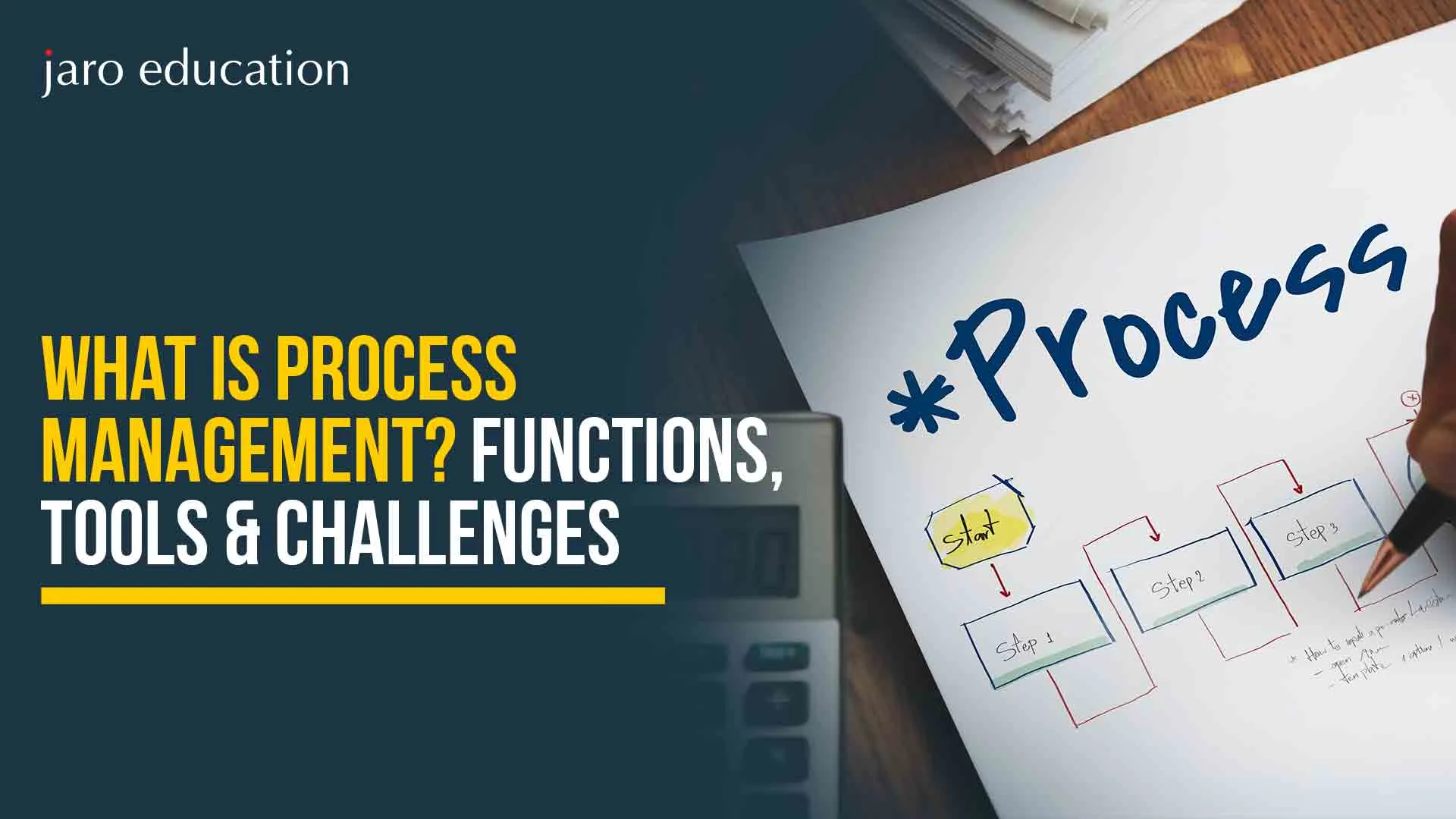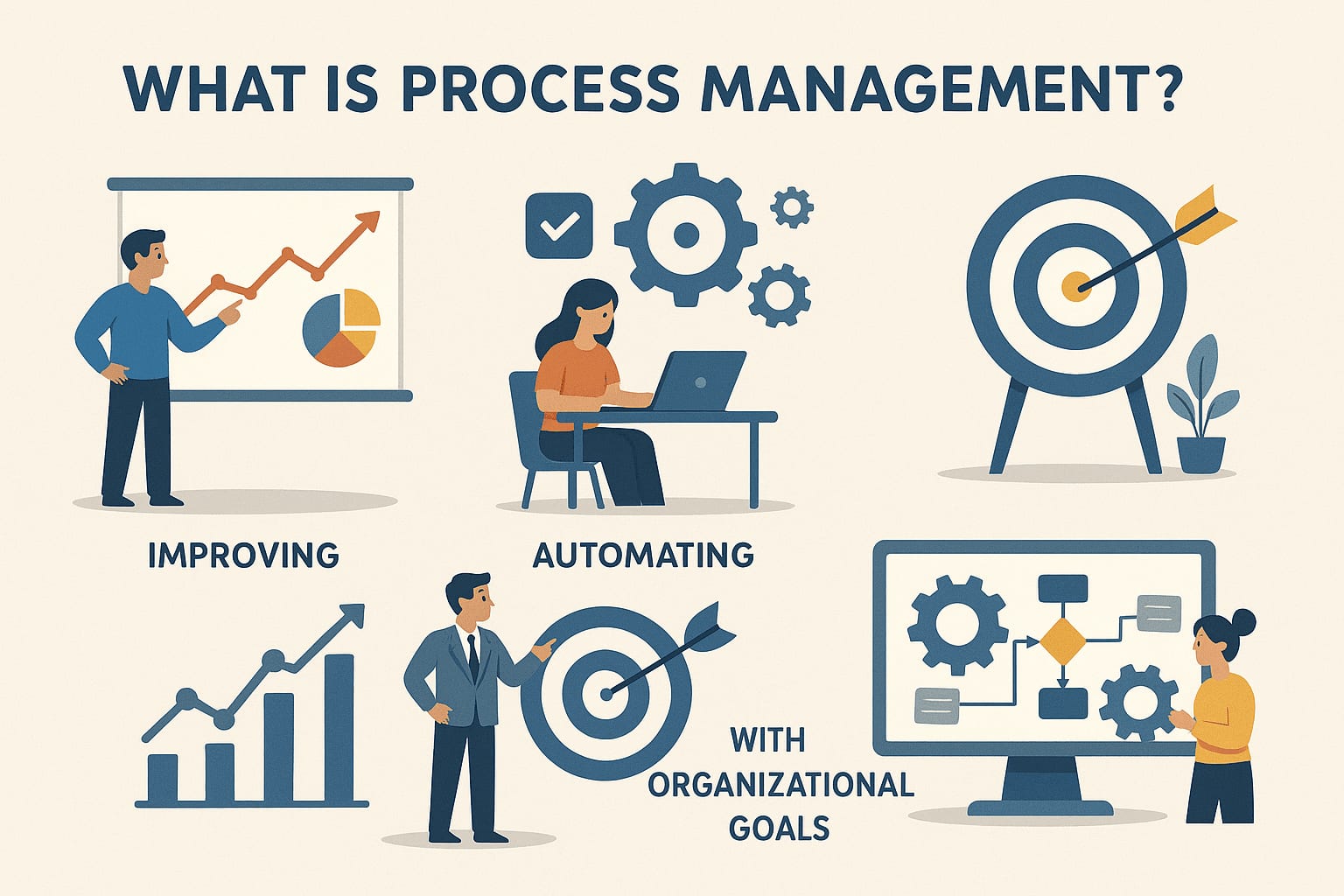What is Process Management? Functions, Tools & Challenges
Table of Contents

- jaro Education
- 17, April 2024
- 2:00 pm
Process management, referred to as Business Process Management (BPM), is a formal framework that improves an organization’s efficiency by enhancing its operating processes, identifying bottlenecks, and implementing other modifications for improvement. It is a planning method that arranges, controls management and optimizes a series of work processes to achieve a business objective more efficiently. Regardless of the scale of your organization, knowing what a process management system is and how software process management works can potentially transform your organization’s productivity and agility.
What is Process Management?

Process management is a business discipline focused on process, which includes improving, automating, and aligning with organizational goals. It helps a company achieve consistency, efficiency, and agility in operations. As companies continue their digital transformation, BPM tools and strategies support standardizing tasks, reducing manual work, empowering automation, and improving effectiveness.
Main objectives of process management system:
- Align processes with business mission and KPIs
- Remove inefficiencies and duplicative steps
- Automate repetitive tasks
- Improve customer experience
- Facilitate scalability and innovation
Core Functions of Process Management
| Function | Role in Business Operations |
| Planning | Defines short-term and long-term process goals to align with business strategy |
| Organizing | Breaks large tasks into manageable modules for better clarity and execution |
| Monitoring | Tracks performance metrics, identifies bottlenecks and supports continuous improvement |
| Motivating | Ensures employee engagement and alignment with process objectives |
Real-Life Examples of Process Management
Now that you know what a process management system is and what its functions are, it may seem like a daunting process. However, that is not the case. The following are some real-life examples of process management systems to help you understand how seamless the whole integration is.
Client Onboarding Process
When organizations obtain new clients, they have to conduct a professional onboarding process for them. A well-defined and clear onboarding process should have the following steps:
- First, the business should schedule a meeting to clearly understand the client’s industry, business strategies, products/services, competitors, and requirements.
- The company then has to assess its assets and goals. It should consider how its resources can fulfil the client’s requirements.
- Next, they have to establish their KPIs. It helps the clients measure their progress.
- Finally, they should create an action plan for their team.
- After framing these strategies, they have to talk with the client, and if the client is satisfied, he/she will accept the proposed strategy. Finally, the company will start working with clients.
Providing Customer Service
Customer service is the key to success for every business. It requires a well-organized software process management system. Let’s see the crucial steps to create a strong customer service process:
- First, be aware of customers’ concerns and issues.
- Integrate a proper CRM to receive their complaints and queries.
- Acquire all the information about the issue from the CRM.
- Then, address the issue.
- Finally, inform the customers about the status of their complaint.
Moreover, the customer service process is involved with other significant processes, such as order and invoice processing, market research processing, new customer onboarding, and more.
Sales Process Management
Another significant example of software process management is the sales procedure. It requires repetitive steps and workflows to meet the ultimate sales goal. A basic sales process goes through this path:

The sales process includes the following steps: sharing proposals, sending quotations, negotiating between the business and customers, receiving orders from customers, maintaining sales records, delivering products or services, conducting post-sale follow-ups, and managing billing and payment processes.
Content Marketing Process
In the modern era of digital technologies, companies need to focus on content marketing for multiple reasons. Whether spreading the word about the brand or a new product or service, offering solutions to customer queries, or simply providing knowledge, content marketing can address all these areas of a business.
Thus, every company should create a powerful content marketing process depending on its strategies. The basic procedure for blog content marketing should go through this way:
At the initial stage, the writer must research, draft, and complete the blog. Meanwhile, the marketer must prepare for marketing and advertising the blog.
After that, there will be a proofreading session to check the grammar, spelling, etc.
The editors will modify the content, rectify the remaining errors, and check whether the content is aligned with the SEO requirements. Moreover, the SEO expert will publish it to check whether the SEO strategy is working.
Finally, the marketer will share the content through advertising, email marketing, and social media to increase its reach and revenue.
Procurement Processing
Every company should go through a process while purchasing a good/service for their business. It’s known as procurement processing. The process includes these steps:
Initially, they have to identify the need for the product/service.
Then, they will contact the purchase department by providing a purchase requisition.
After getting the requisition, the purchasing department will review it.
Then, a requisition for budget approval will also be sent to the purchase department. This requisition includes all the financial details.
After approving a quotation request, the purchasing department will send the quotation to the suppliers.
Then, there will be a vendor selection. After that, a contract will be signed.
Next, the company will receive the product and invoice slip.
After inspecting the product’s quality, the company will approve the payment.
Top Process Management Tools (BPM Software)
| Tool | Features |
| Quixy | No-code builder with drag-and-drop automation |
| Kissflow | Low-code BPM tool for process automation and dashboard insights |
| ProcessMaker | Workflow design with Slack, Gmail, and WhatsApp integrations |
| Pipefy | Native connectors and a visual tracking dashboard |
| CMW Lab | Low-code automation and mobile-first UI |
| Creatio | Visual BPM platform for real-time team collaboration and automation |
Now, let’s shift our focus to the tools that enable process management system for businesses:
Quixy
Quixy is a no-code automation platform and BPMS that helps users automate, model, optimize, and track business process workflows. It incorporates simple drag-and-drop application builders to design, build, and deploy apps. This tool’s app-building process has five simple steps. This platform offers enterprise-grade security to protect users’ data. Moreover, it can be integrated with third-party apps to enhance its capabilities.
Kissflow
Kissflow guides users to automate and execute business processes. This low-code BPM software process management helps users execute processes within a few steps. According to a report by Forrester Wave, this platform will become a strong performer in low-code platforms for citizen developers in 2024. With Kissflow, people should simply define their workflows, customize them, and apply for permission to onboard for working with the platform. Later, the dashboard of this platform shows insights like metrics for process efficiency, workflow visualization, and data summary.
ProcessMaker
This BPM platform lets organizations design workflows with a user-intuitive interface and drag-and-drop functionalities. This platform comes with a personalized dashboard for processing and monitoring business requirements, SLAs, and objectives. This tool helps users capture and distribute data to automate process management system tasks. It integrates with Gmail, WhatsApp, Slack, and Twitter. Moreover, ProcessMaker encourages users to create their own set of rules and conditions to send alerts to stakeholders about important updates.
Pipefy
Pipefy, the no-code BPM tool, assists organizations in streamlining and improving the performance of process management. The users can create the most efficient version of the process by implementing the right starting points and phases. It has several native integrations, 300 native connectors, and APIs to build a symmetrical working environment. This tool has a request tracker that allows employees, customers, and vendors to track their request status. This platform has been recognized as the industry leader in G2, 2023-’24.
CMW Lab
Being a low-code process management system software, CMW Lab helps users build innovative business applications and manage data, documents, and tasks. The interesting fact about this platform is that it also has a mobile-friendly, personalized user interface. It includes significant features like drag-and-drop functionalities, chatting with teammates, process automation, effective work cycle management, and more. Now it has become the number one BPM software process management, according to the Gartner Peer Insights.
Creatio
Creatio, the no-code automation platform, is an excellent BPM and project management platform. It supports the users in creating process diagrams with the visual tools and archiving them within the process libraries. It provides powerful solutions for automating marketing campaigns, sales processes, and customer service workflows. Moreover, it allows users to collaborate with their teammates in real time. As a result, they can visualize the processes remotely, edit the processes together, and comment on them. This platform got first place in the Customer Service Solutions Report of Forrester in 2024.
Steps to Implement Process Management in a Business
The steps of process management incorporate a structured and cyclical approach for streamlining the management, operations, and supporting processes. So, let’s get into a deep dive into the process management steps—
Step 1. Determine Your Approach
Identify which high-impact processes map to your KPIs. Identify which BPM approach you need to adopt: Human-centric, Document-centric, or Integration-centric.
The human-centric approach is end-to-end and associated with manpower. That means the employees, customers, vendors, and other people involved in the process. This type of BPM approach includes well-crafted application interfaces, function tracking, and notifications. The best example of the human-centric approach is HR personnel’s workflows, such as posting job openings, candidate screening, interviewing, etc.
Document-centric BPM is involved with electronic-based and paper-based document processes. This approach solves the requirements of individual organizations, industry, and business regulations. This BPM approach can be performed with workflow automation tools and techniques to improve accuracy. The perfect examples of a document-centric approach can be seen in the agreements and contracts-related tasks in finance, medical, legal, and purchasing fields.
Integration-centric BPM helps people quickly access any app, service, and data through the power of APIs. Moreover, this approach becomes suitable for automating systems like customer relationship management (CRM), human resource management systems (HRMS), and enterprise resource management (ERP) apps. The common examples of this BPM are conducting sales and marketing campaigns, sharing information about potential customers, and more.
Step 2. Design and Map the Process
After the implementation of proper strategies, organizations need to map out the desired processes. Thus, they should identify the major process events, manual and automated tasks required for those events, the human resources for performing the tasks, technologies/tools, and deadlines.
Additionally, they must consider and understand the ‘as-is’ states, such as bottlenecks, unnecessary error-prone tasks, delays, human errors, redundancy, high costs, compliance issues, and customer dissatisfaction, to create new business requirements. After understanding the ‘is-as’ states, they have to design and depict the ‘to-be’ states. For these, one should find different methods to solve the issues, outline business process improvement, ask the stakeholders for their opinions, gain feedback for the designs, and more.
Step 3. Model and Test the Process
Now, it’s time to conduct a test for the right design. For this, a company will design a prototype of the desired model. This prototype must include all the data flows, activities for the process, and business rules. After that, the model should be tested with simulation runs. The simulations can be run with different types of variables, like costs, resources, and time. Then, based on the result, they will change and test the model again and either modify its existing workflows or implement the new ones. This simulation modeling approach becomes a cost-effective method for examining process performance in several circumstances.
Also, organizations use different business process management software (BPMS) to automate, test, and analyze the model for better performance.
Step 4. Optimize and Enhance
Then, it’s time for process optimization and improvements. So, organizations need to perform small group tests like proof-of-concept solutions. After that, they use the feedback to improve and evolve the process. In this phase, the BPMS’s in-built templates and connectors help the organizations create instinctive user interfaces.
But before the final launch, if the organization changes the management plans and adds new resources, it needs to avoid operational interruptions, finalize the metrics, generate real-time reports, and promote adoption.
Also, they need to update job roles and responsibilities, conduct new training sessions for employees, and notify and support affected suppliers and customers. These are the essential modifications required to suit the change in the management plan.
Step 5. Monitor and Track Performance
This step involves monitoring data to gather performance metrics. The monitoring and analysis of performance metrics depend upon the feasibility of the process, such as how good a workflow performs within a process, the functionality of a process within a large organization, and operating a process from a technical perspective. Also, it’s necessary to have a conversation with the stakeholders to improve their knowledge about the cost, saving time, and bottlenecks.
Moreover, the BI and BPMS tools help organizations in metrics generation, visualization, analysis, and reporting. These elements help them to know and comprehend the industry benchmarks to understand how they estimate the organization’s KPIs. Furthermore, regular monitoring of the metrics is crucial for maintaining consistency within the process of achieving the business goals.
Step 6. Use New Knowledge for Continued Optimization
Organizations gain actionable insights after the monitoring and tracking phases. Depending upon these insights, they improve the business process. Side by side, they conquer operational efficiencies through regular innovation and iteration. Also, this phase leads them to explore other opportunities for automation, integration, and standardization. Then, based on the changing requirements, marketplace conditions, and business strategies, they can implement new approaches to refine the process.
Challenges of Implementing Process Management in a Business
With all the necessary details of process management out of the way, let’s understand the challenges that organizations face while implementing BPM –
- Process Complexity
Process complexity is one of the major concerns for BPM. The complexity occurs due to a variety of practices and systems throughout different departments and stakeholders. The lack of documentation, optimization, clarity of roles and responsibilities, and understanding will make the process more hectic. As a result, the overall process causes several bottlenecks, inaccuracies, and failures.
To overcome this challenge, organizations should implement proper documentation and process mapping. BPM tools help create sophisticated process mapping, visual representations of the process, and identification of bottlenecks.
- Lack of Control and Governance Framework
Lack of control causes potential errors and inadequacies, and sacrifices quality standards and compliance within a process. Thus, every organization should establish a proper centralized governance structure to mitigate these risk factors.
To establish the right governance structure, an organization should define clear policies and procedures to ensure that the process management aligns with the business objective. The BPM tools can help build the standard governing and controlling framework to maintain the governance standard.
- Unacceptance of Change
Change management is a crucial factor for BPM. However, the employees and stakeholders may be scared about changes, such as new technologies and processes. For example, a logistics company is implementing automated BPM solutions over manual BPM solutions. As a result, the employees who perform these manual tasks may resist the acceptance of the new change. They may fear that automation will replace their job role.
To overcome this issue, the company should conduct proper training sessions for the skill development of the employees. Also, the company must have a transparent communication strategy to help the employees understand the benefits of the changes for their growth, efficiency, and business growth.
How an Online MBA from Manipal University Jaipur Can Empower Your Process Management Journey
In today’s fast-paced commercial landscape, businesses need people who can not only think about core business functions but can also improve processes and think strategically. An Online MBA Program from Manipal University Jaipur addresses those needs for both new and established professionals.
The Online MBA Program from Manipal University Jaipur is comprehensive and covers the essentials of modern business and fits into the following areas:
- Business Process Management (BPM)
- Digital Transformation
- Operations and Supply Chain Management
- Strategic Leadership
- Data-led Decision-Making
No matter if you are a working professional modernizing your skills or a graduate trying to future-proof your career, this flexible Online MBA Program will help you:
- Work with industry experts
- Get hands-on exposure with BPM tools and frameworks
- Understand competence with end-to-end process mapping/cycle time and performance monitoring
- Help your organization innovate and digitally transform processes through automation
The program is offered in partnership with Jaro Education, providing career consulting support, real industry projects, and industry relevance across the globe.
Become a BPM focused business leader through the flexibility of an Online MBA Program, that fits your life and goals. Find out more about the Online MBA Program from Manipal University Jaipur, right now.
Jaro Education: Your Trusted Counselor for Career Guidance and Growth
Whether you’re dealing with the challenges of business process management or simply trying to figure out which MBA program will work for you, Jaro Education acts as a personal career consultant. Jaro Education has over 14 years of experience in higher education, helping both professionals and students choose relevant programs in industry, like the Online MBA offered by Manipal University Jaipur.
Here’s how Jaro Education supports you on your journey:
- Personalized counseling based on Career objectives
- Connections with globally recognized universities and future-ready programs
- Information about selecting specializations, such as Operations, HR, Finance, and Digital Strategy
- Support weirdness, admission, onboarding, and learning on your academic journey
When it comes to planning your career, expert counseling from Jaro Education makes your next strategic move with confidence.
Conclusion
Knowing the principles of process management and its functions and tools helps you, as a business owner or a professional, to fulfill organizational goals with a strategic approach. It reduces deficiencies and errors within a process. Though there are some challenges in implementing process management, acquiring effective strategies, technologies, and best practices helps to overcome these challenges. So, go for the Online MBA Program at Manipal University Jaipur. It will help to implement a strategic approach to business process management. For more details, contact Jaro Education.
Frequently Asked Questions
Process management helps streamline workflows, reduce redundancies, and automate tasks to improve overall operational efficiency and productivity in an organization.
Business process management tools like Kissflow, Creatio, or Quixy automate repetitive tasks, track progress, and integrate systems to make workflows faster, smarter, and more accurate.
Examples include onboarding clients in IT firms, managing procurement in manufacturing, automating sales funnels in eCommerce, and standardizing customer service processes in telecom companies.
Process mapping helps identify bottlenecks, visualize inefficiencies, and redesign workflows for better outcomes, making it a critical part of process improvement strategies.
Human-centric BPM involves tasks that require manual intervention (like HR workflows), while integration-centric BPM automates processes using APIs and tools (like ERP or CRM integrations).
An online MBA program (like the one from Manipal University Jaipur) covers BPM tools, process optimization, operations strategy, and leadership skills that prepare you for managing large-scale processes.
Common challenges include lack of clarity in processes, resistance to change from employees, poor documentation, and lack of automation tools to support the BPM framework.
It provides a structured approach to modernizing legacy systems, integrating digital tools, and creating agile workflows aligned with organizational goals and customer expectations.










